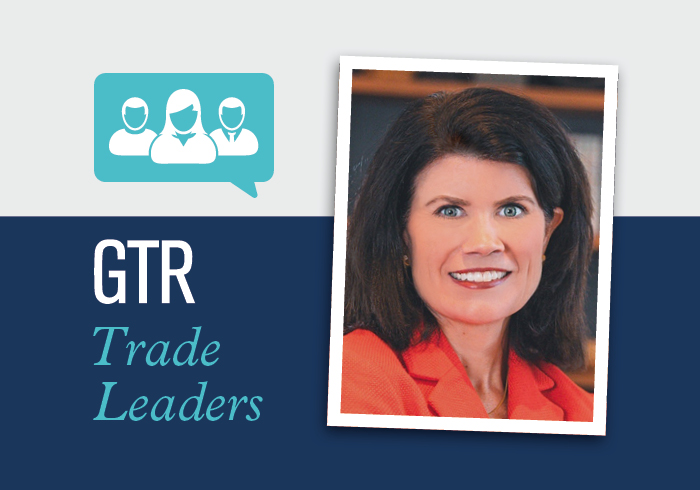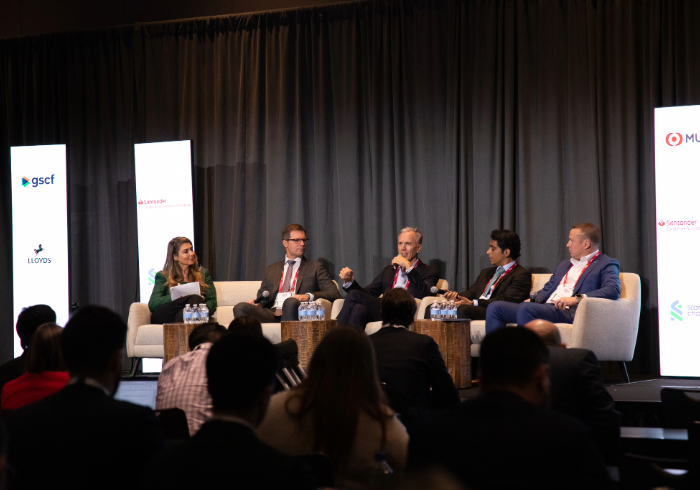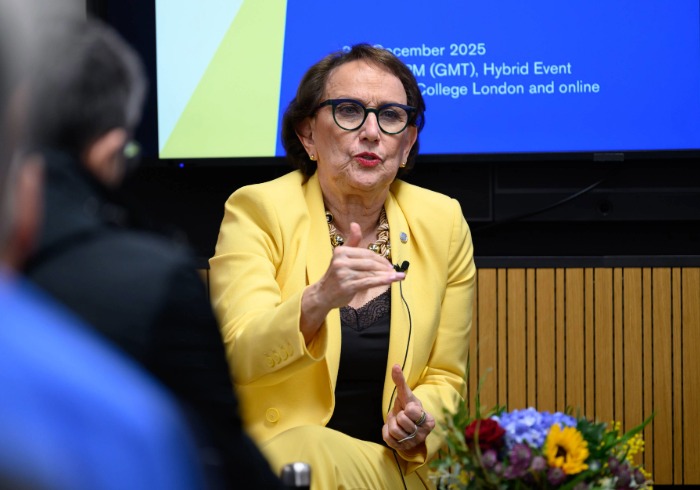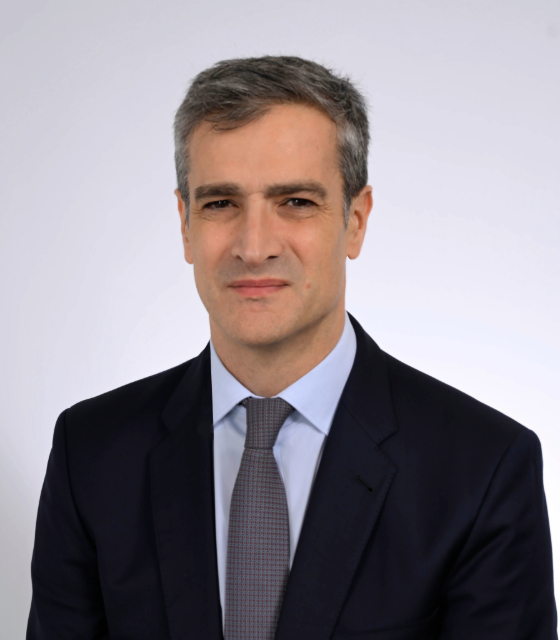In 2021, JP Morgan created the role of global head of supply chain finance (SCF) to reflect the growing strategic focus on the business, and tapped long-time executive Heather Crowley to lead it.
Based in New York, Crowley now oversees the bank’s global trade and working capital product strategy, product delivery and innovation efforts. Her focus includes embedding SCF into clients’ existing systems and identifying opportunities to unlock working capital earlier in the supply chain.
Speaking with GTR at the Sibos conference in Frankfurt in early October, Crowley outlines how the bank’s SCF strategy has evolved, where the next phase of innovation is likely to come from, and what qualities she looks for when building out her team.
GTR: It’s clear from the conversations I’m having here at Sibos that supply chains are still under a lot of pressure. From what you’re seeing through a JP Morgan lens, what are the biggest challenges clients are facing right now? And how is SCF evolving to help them navigate all of that?
Crowley: One of the big themes we’re seeing from corporate clients right now is uncertainty, driven by geopolitical shifts and the post-Liberation Day environment. Because of that, treasurers are focusing more on working capital, especially in sectors like auto, where we’re seeing a move back to just-in-case inventory strategies.
Rising supply chain costs – whether from tariffs or raw materials – are also putting pressure on resilience. Treasurers and CFOs need to be able to react quickly, and that’s where supply chain finance comes in. It’s always been important, but it’s even more critical than ever.
A lot of the traditional barriers to accessing supply chain finance are starting to come down. From the buyer side, you’re seeing more embedded solutions. On the supplier side, there’s more digitisation to make it easier for them to tap into it.
We learned a lot post-Covid. Back then, it was 20% of suppliers making up 80% of working capital. Now, corporates really understand the health of the full supply chain is essential – knowing your suppliers can stay afloat matters more than ever.
That means banks and fintechs need to keep removing friction so suppliers can actually use these tools. Your large, strategic suppliers already know how to navigate factoring and supply chain finance. But when you get to the mid and smaller suppliers, you have to make it simple and intuitive so they can access it too – and so buyers can unlock that liquidity.
One area that can really help here is AI. It can surface opportunities across the supply chain, even once a programme is already up and running. Whether it’s for buyers or suppliers, AI can highlight discounts or terms that weren’t being fully taken advantage of.
GTR: Your appointment four years ago marked the creation of a new global head of SCF role at the bank. How have you approached building out that mandate? What have been your main priorities in shaping the global SCF offering?
Crowley: Since 2021, we’ve gone through a full transformation of our supply chain finance franchise. Starting with the technology, we completely overhauled the UI and UX. The whole experience has been reimagined to be embedded, seamless and low lift from the buyer’s side, making sure they can access what they need easily, whether it’s reporting or supplier tools.
Equally important, we focused heavily on the supplier onboarding experience. We wanted it to be fast and frictionless; not just to compete with other banks, but to truly differentiate from fintechs. That’s where I think we’ve seen a real shift, by putting the supplier experience at the centre and making sure every supplier can actually take advantage of supply chain finance.
The space has evolved. It’s no longer just about buyers optimising working capital. It’s about true end-to-end value, which is why we’ve also invested in our internal tech tools. Whether you’re a programme manager working with a buyer or in supplier sales, when you log in, you have a dashboard showing the real-time status of everything. No more multiple systems or spreadsheets. Our supplier support, buyer support and client service teams are all plugged into one best-in-class platform.
But it’s not just tech. A strong supply chain finance programme can last decades, so we made sure to bring in top industry talent. The same leaders you see on stage at conferences are the ones working with our clients at JP Morgan. If you’re in Latin America, we’ve got someone who understands complementos de pago in Mexico or invoice registration in Brazil. If you’re in India, we know RBI regulations. Our clients rely on us to guide them through the local landscape, and that means knowing the language, the customs and the regulations.
We’ve also built our team to support clients through change, whether it’s a divestiture, a merger or a spin-off. This isn’t a set-it-and-forget-it programme.
The transformation has really been about investing in both the technology and the people. And we’re not done. We’re going to keep investing.
GTR: Where do you see the biggest opportunities for the next phase of growth and innovation in SCF? What’s the next priority for you and your team?
Crowley: Number one, you’re going to hear a lot about embedded solutions. JP Morgan is currently the only bank with Oracle fully embedded. But it’s not just Oracle, we’re also live with an embedded SAP solution. The goal is to commercialise these solutions and make them widely available.
The next big area of focus – for us and for the industry – is rethinking where supply chain finance fits. Right now, it’s typically the tail end of the supply chain, dealing with confirmed receivables. But there’s a huge opportunity to unlock working capital earlier in the process.
GTR: Following your recent collaboration with Oracle, what else are we going to see coming from that embedded finance space?
Crowley: For embedded solutions, the real benefit is how much easier it’s become for corporates to adopt supply chain finance. If you go back to 2021, most companies were still doing host-to-host connections, which meant launching a programme was an internal IT project. Treasurers and CFOs had to prioritise it alongside everything else, and even then it could take three to six months to get up and running. That was a real barrier.
Now, with ERP platforms like Oracle embedding JP Morgan’s supply chain finance directly into the system, all our clients have to do is set up and go live. It’s a huge shift. For example, I’m working with a large logistics company right now. Just getting a supplier analysis file used to take them weeks. Now, with Oracle, it’s the push of a button. The data’s right there, the analysis is instant, and implementation is fast. These embedded solutions let clients access financial tools right within their ERP, which is critical. They’re under pressure to get ROI from platforms like Oracle and SAP – these are huge investments. Now they can use those systems more efficiently, without taking on additional tech debt or having to maintain extra tools.
So going forward, I expect we’ll see more embedded solutions and more partnerships. The shift is that instead of clients spending their own tech dollars and resources, they’re looking to providers like us to take on the heavy lifting. That’s a major change. We’re being asked to deliver more of the tech uplift – and we can.
It all ties back to interoperability. As more digital solutions come online, clients don’t want to maintain multiple systems. They want everything to work within their existing ecosystem. That’s exactly what we’re focused on: delivering embedded, interoperable solutions that meet clients where they are.
GTR: When you’re looking to partner with tech companies, what are the qualities you’re really looking for? What makes a partnership stand out for you?
Crowley: Best in class, right? That’s the baseline. I need to know that any vendor I work with is going to deliver the same level of reliability and stability to my clients that I do. That’s one thing JP Morgan is consistently counted on for.
First and foremost, I’m looking for a partner that brings that same continuity to the table. After that, it’s about innovation; do they share the same goals and objectives? Are they truly partnering to bring value to our clients?
Solutions like the one we just talked about, where JP Morgan supply chain finance is embedded into Oracle, that’s exactly what my clients are looking for. It’s low lift, it’s integrated, and it works for them.
GTR: When you’re building out your product and leadership teams, what are the top qualities or skills you look for? And for someone just starting out in trade or supply chain finance, what kind of experience do you think really sets them up for success?
Crowley: It really comes down to two things. First is innovation: being future-focused and always thinking about the art of the possible. That’s absolutely key for me. But innovation doesn’t happen in a vacuum. The one requirement I have is that product leaders are deeply connected with clients.
That connection is critical because real innovation takes time. You need leaders who are close enough to clients that they’re already thinking ahead – building products clients don’t even know they need yet. I want people who are constantly out there, engaging, asking questions, listening – really anticipating what’s coming.
And when I talk to young leaders joining the organisation, I always give two pieces of advice. First, get hands-on. If you’re going into structured trade, do a spend file analysis, meet with a supplier, implement a client. If you’re in core trade, review a letter of credit, dig into the discrepancies, sit with the ops team. Really understand the full process end-to-end. That kind of experience makes you incredibly valuable to clients.
Second, always be in front of the client. Always. Clients will tell you exactly what their challenges are. You might think you’re doing a great job based on your P&L, your KPIs, or how good your booth looked at a conference – but the real insight comes from walking through the client’s process, side by side with them. That’s where the transformation happens.








